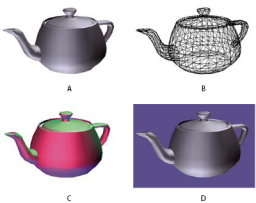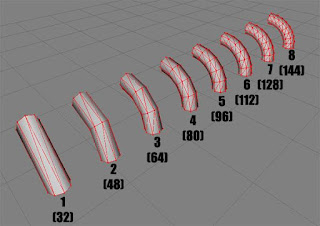P1; Understand theory and applications of 3D
Applications of 3D:
Displaying 3D Polygon Animations:
Application Programming Interface: eg Direct3D, OpenGL
An application programming interface, also known as API, is the interface that processes the various tools and routines to express the software component for different inputs, outputs and operations.
Graphics Pipeline: eg modelling, lighting, viewing, projection, clipping, scan conversion, texturing and shading, and display.
Graphics Pipeline, also know as Rendering Pipeline is the series of steps taken to create 2D raster images as a representation of a 3D scene.

Rendering Techniques: (Radiosity, Ray Tracing)
Radiosity is the method that is used based on detailed information of reflected light from diffused surfaces.
Ray Tracing generates the path of light through an image using pixels.
Distributed Rendering Techniques:
Distributed Rendering is often to referred to as Parallel Rendering, it is a complex computed sequence that renders parallel objects in multiple domains.
Lighting:
Lighting, or shading, is used the emphasize the shape and structure of a 3D object.
Textures:
There are various textures you can use to help give a better look to an object, different textures will give the shape its uniqueness. For example adding a bricked texture to a wall will give it more of an identity as to what it is.
Fogging:
Fogging is apart of the rendering process. It fades, or fogs, out the background as you move further away from it. Shadowing:
Creating the right shadows comes in with creating the correct lighting and shading, once the lighting is set, adding shadows will create a more realistic effect.
Vertex and Pixel Shaders:
Vertex and Pixel Shaders are used within HLSL, which is a programming language used to implement shaders. The language creates programs for GPU's.
Level of Detail:
When referencing the level of detail within the 3D Modelling capacity, decreasing the complexity of the selected 3D object as it moves further away from view.
Geometric Theory:
Vertices:
Vertices is the plural for vertex. A vertex in 3D Modelling is the point of an object where three or more edges intersect. These are often the X,Y,Z elements of the object or edge.
Lines:
A line is a straight edge with a vertex at either end. Curves:
A curve, similar to a line, has a vertex at each end, as well as at least one vertex in the middle.
Edge:
An edge is self explanatory, it is the joining of two faces of an object.
Polygons:
A polygon is a shape with at least three sides, typically five or more. It also must have angles.
Element:
An element is a part of what makes the mesh of the model. It is any part of the model, it could be a vertex, a line or any of the other terms explained here.
Face:
Using a cube for an example, it has six faces. Each face can be edited separately within modelling. This allows for the faces to change the values and appearance of the object.
Primitives:
A primitive is a simple geometric shape which can take place in various forms such as a cube or a cylinder. The most notable elements within a primitive are the points, lines and line segments as well as the planes and spine curves.
Meshes: eg Wire frame
A mesh is a barrier that is made of connecting elements, in terms of 3D Modelling a mesh is the wire frame of an object. This is before you fill he object with a shader or toon.
Coordinate Geometry: (2D/3D)
Coordinate Geometry focuses mainly within graphs using lines and curves. It also uses algebra to connect to the geometric element of 3D modelling.
Surfaces:
In terms of 3D Modelling, a surface reefers to the area in which you build the object upon, for example a surface could be a floor or some stairs.
Mesh Construction:
Box Modelling:
Box modelling is where you take a standard shaped polygon, a cube for example, and manipulate the shape into an object, for an example a human hand.
Extrusion Modelling:
Extrusion Modelling is very similar to box modelling, but more intricate. An example would be a creature or humans face. Extruding elements such as the nose, lips and eyes.
Using Common Primitives: eg Cubes, Pyramids, Spheres, Cylinders
Common Primitives are used when box modelling.
3D Development Software:
Software: eg, 3D Studio Max, Maya, Lightwave, AutoCAD, Cinema4D
There are various different software to model using 3D elements. The above examples are the most commonly known, as well as the most industry used software.
Each of the software above allow you to create and export 3D models.
File Formats: eg, 3ds, .mb, .lwo, .C4d, and plug-ins.
In order of the above examples, the following pieces of software use these file formats:
- 3D Studio Max
- Maya
- Lightwave
- Cinema 4D
The file format your model is saved in is important, if you create a model in Maya, then it must save as a .mb file.
Constraints:

Polygon Count:
A Polygon Count is the amount of polygons that are being rendered per frame, for example; 300poly per frame. The less polygons within an object, the more rigid would appear.
File Size:
3D Model files are of significant size, so trying to reduce the size is a must. This can be done by reducing the Polygon Count.
Rendering Time:
The rendering time is very important, the object, or objects, must render in good time in order for the models to be seen as fast as possible. In terms of in a game, rendering time must be spot on, especially when the character is walking around an open world.
Displaying 3D Polygon Animations:
Application Programming Interface: eg Direct3D, OpenGL
An application programming interface, also known as API, is the interface that processes the various tools and routines to express the software component for different inputs, outputs and operations.
Graphics Pipeline: eg modelling, lighting, viewing, projection, clipping, scan conversion, texturing and shading, and display.
Graphics Pipeline, also know as Rendering Pipeline is the series of steps taken to create 2D raster images as a representation of a 3D scene.

Rendering Techniques: (Radiosity, Ray Tracing)
Radiosity is the method that is used based on detailed information of reflected light from diffused surfaces.
Ray Tracing generates the path of light through an image using pixels.
Distributed Rendering Techniques:
Distributed Rendering is often to referred to as Parallel Rendering, it is a complex computed sequence that renders parallel objects in multiple domains.
Lighting:
Lighting, or shading, is used the emphasize the shape and structure of a 3D object.
Textures:
There are various textures you can use to help give a better look to an object, different textures will give the shape its uniqueness. For example adding a bricked texture to a wall will give it more of an identity as to what it is.
Fogging:
Fogging is apart of the rendering process. It fades, or fogs, out the background as you move further away from it. Shadowing:
Creating the right shadows comes in with creating the correct lighting and shading, once the lighting is set, adding shadows will create a more realistic effect.
Vertex and Pixel Shaders:
Vertex and Pixel Shaders are used within HLSL, which is a programming language used to implement shaders. The language creates programs for GPU's.
Level of Detail:
When referencing the level of detail within the 3D Modelling capacity, decreasing the complexity of the selected 3D object as it moves further away from view.
Geometric Theory:
Vertices:
Vertices is the plural for vertex. A vertex in 3D Modelling is the point of an object where three or more edges intersect. These are often the X,Y,Z elements of the object or edge.
Lines:
A line is a straight edge with a vertex at either end. Curves:
A curve, similar to a line, has a vertex at each end, as well as at least one vertex in the middle.
Edge:
An edge is self explanatory, it is the joining of two faces of an object.
Polygons:
A polygon is a shape with at least three sides, typically five or more. It also must have angles.
Element:
An element is a part of what makes the mesh of the model. It is any part of the model, it could be a vertex, a line or any of the other terms explained here.
Face:
Using a cube for an example, it has six faces. Each face can be edited separately within modelling. This allows for the faces to change the values and appearance of the object.
Primitives:
A primitive is a simple geometric shape which can take place in various forms such as a cube or a cylinder. The most notable elements within a primitive are the points, lines and line segments as well as the planes and spine curves.
Meshes: eg Wire frame
A mesh is a barrier that is made of connecting elements, in terms of 3D Modelling a mesh is the wire frame of an object. This is before you fill he object with a shader or toon.
Coordinate Geometry: (2D/3D)
Coordinate Geometry focuses mainly within graphs using lines and curves. It also uses algebra to connect to the geometric element of 3D modelling.
Surfaces:
In terms of 3D Modelling, a surface reefers to the area in which you build the object upon, for example a surface could be a floor or some stairs.
Mesh Construction:
Box Modelling:
Box modelling is where you take a standard shaped polygon, a cube for example, and manipulate the shape into an object, for an example a human hand.
Extrusion Modelling:
Extrusion Modelling is very similar to box modelling, but more intricate. An example would be a creature or humans face. Extruding elements such as the nose, lips and eyes.
Using Common Primitives: eg Cubes, Pyramids, Spheres, Cylinders
Common Primitives are used when box modelling.
3D Development Software:
Software: eg, 3D Studio Max, Maya, Lightwave, AutoCAD, Cinema4D
There are various different software to model using 3D elements. The above examples are the most commonly known, as well as the most industry used software.
Each of the software above allow you to create and export 3D models.
File Formats: eg, 3ds, .mb, .lwo, .C4d, and plug-ins.
In order of the above examples, the following pieces of software use these file formats:
- 3D Studio Max
- Maya
- Lightwave
- Cinema 4D
The file format your model is saved in is important, if you create a model in Maya, then it must save as a .mb file.
Constraints:

Polygon Count:
A Polygon Count is the amount of polygons that are being rendered per frame, for example; 300poly per frame. The less polygons within an object, the more rigid would appear.
File Size:
3D Model files are of significant size, so trying to reduce the size is a must. This can be done by reducing the Polygon Count.
Rendering Time:
The rendering time is very important, the object, or objects, must render in good time in order for the models to be seen as fast as possible. In terms of in a game, rendering time must be spot on, especially when the character is walking around an open world.


No comments:
Post a Comment